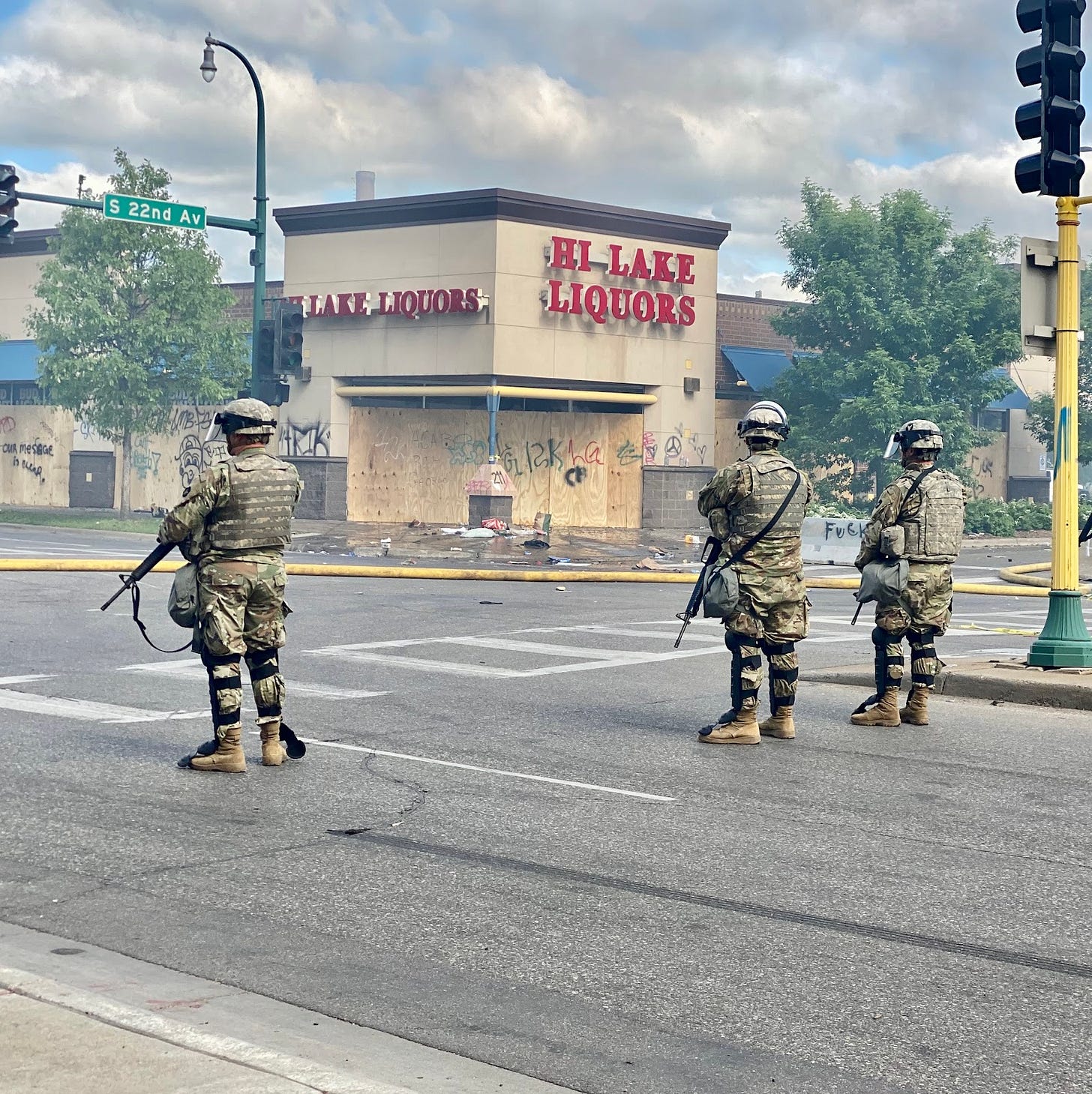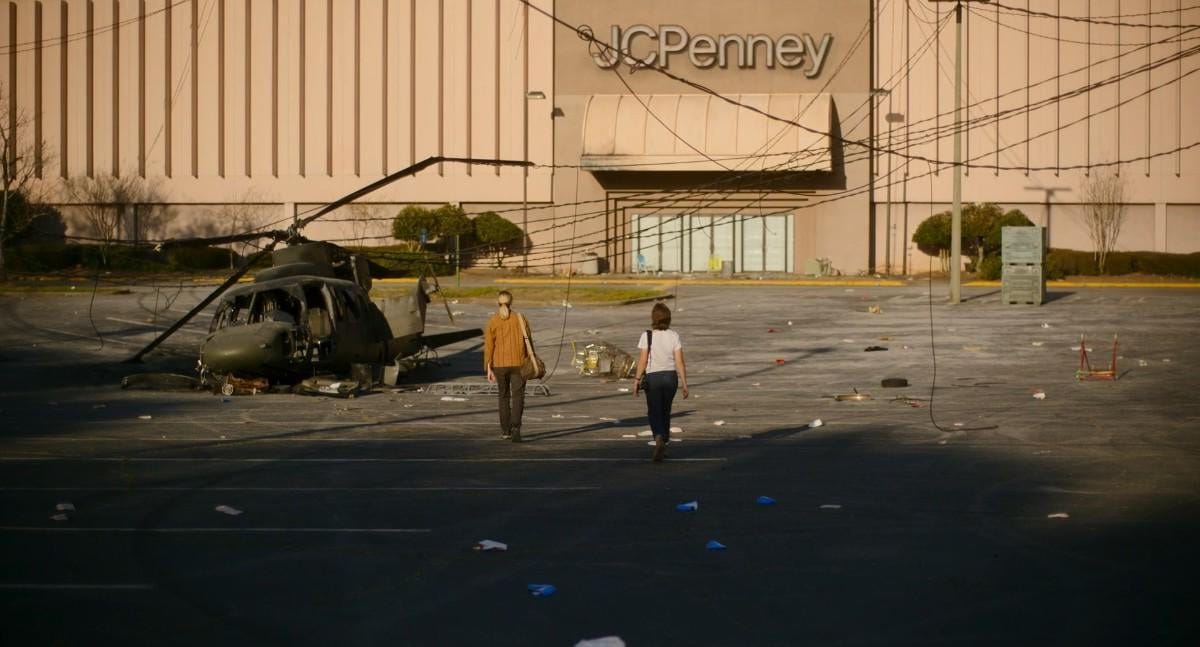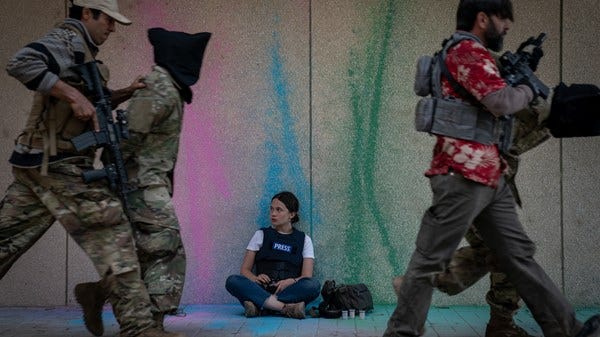"Civil War," Meaning Making, and the Death of the Author
on the role of art & what we do with stories
Note: As I worked on this essay, student protests in solidarity with Palestine and subsequent brutal police repression started sweeping the country. The images in the film Civil War will feel dramatically foreign to some, but familiar to others, and even more now after this most recent wave of police violence. I hope that if you’re reading you agree: for many marginalized groups in the so-called US, the apocalypse has already happened several times over; that there is already daily war waged against poor people, Black and Indigenous people, immigrants, and trans people. It was beyond the scope of the essay to dig into this obvious point, but, to make clear that this is not entirely unprecedented, this post features images from Minneapolis that I took in early June of 2020, about 13 blocks from where I was living at the time, mixed in with images from the movie.
“....the birth of the reader must be ransomed by the death of the Author.” - Roland Barthes
For at least two weeks I thought Civil War was a new Marvel movie. I wondered why Kirsten Dunst was in it. When I saw that it was getting buzzy, I did a little more investigating, read the synopsis, and asked Peter if we should check it out for our Return to the Theater (after months of missing—due to chemo and an obscenely busy work schedule — our beloved tradition). “I don’t have high hopes for the politics,” I said, which is what I usually say about movies that try to offer some kind of message. But as I wrote in response to the Barbie discourse: I don’t look for revolutionary guidance from Hollywood.
So, yes, P and I agreed, it’s important to see how a popular film is portraying a near-future dystopia featuring a major conflict on US soil. Back to the theater we went.
The movie, written and directed by Alex Garland (Ex-Machina, Annihilation), begins with a group of journalists covering chaos in New York City. A small riot turns into the site of an American flag-weilding suicide bomber attack. Spared from the explosion are Lee Miller, a hardened photojournalist played by Kirsten Dunst; the eager aspiring photographer Jessie (Cailee Spaeny); and Joel (Wagner Moura), who is all at once a skeezeball, a so-so friend, and an adrenaline-addicted reporter.1 Back at the hotel where the journalists are convening, we meet Sammy (Stephen McKinley Henderson), the elder New York Times staffer who doesn’t want to retire before at least trying to cover the collapse of US democracy. In a quick conversation we learn almost the full extent of the context we’ll get for the rest of the film: there’s a civil war, the Western Forces (an alliance made up of California and Texas) are gaining momentum and it looks like they may actually oust the president. The president, played by Nick Offerman, is in his third-term, he’s disbanded the FBI, and he’s refusing to admit that the end is near. This conversation also reveals some of the more minor factions (including “Portland Maoists”), and we learn that the only way to DC from New York is to go through Pittsburgh and West Virginia, adding a few hundred miles to the route. The highways are nearly non-functional, there are regular power outages, and the internet is slow to non-existent.
With that, the road trip begins. Lee, Sammy, Joel, and—to Lee’s dismay — Jessie pile in the press van to make their way through rural and suburban America. Almost instantly we’re met with images of brutal violence: the torture of two looters (Lee turns it into a photo op with the torturer); a random shoot-out between two vaguely queer coded characters and an unknown person shooting from a mansion (Joel asks what they stand for, to which they more or less respond with “not getting shot.”); an extremely tense military operation between ostensible guerrilla fighters (in Hawaiian shirts) and US military members, in which our journalist friends are informally embedded in the action for picture taking. (The scene ends with a point-blank execution of the captured soldiers and shortly after Joel shouting enthusiastically, “What a rush!”). The violence hits closer to the protagonist’s crew when they stumble upon a small squad of likely US troops tossing quicklime into a pit of bodies. Their coldblooded leader is played perfectly by Jesse Plemmons.2 It’s important to note here that the majority of prominent deaths we see on screen before the final climax of violence befalls people of color; in one instance this happens because the person doing the killing is an overt white supremacist. The other deaths — both of which involve Black men bleeding out from gunshot wounds — were a choice that had no connection to the storyline (in terms of the race of the characters). Was this exploitative for a white director to do, or was it proving one of his potential points about the kind of brutality we witness on our screens so often?
The meaning of the particular deaths on screen is one of many, many questions that the film leaves us with. More on that in a moment, but let me say here, by way of review, that I have almost never felt so viscerally gripped in a movie theater as I did throughout the horror —juxtaposed with brief (very brief) moments of human connection—we experience in Civil War. I had the overwhelming urge to cry for about a full hour of it, and I finally did; when the credits rolled, I weeped. That’s not terribly uncommon for me, but it usually comes after a film that utilizes skillful emotional manipulation. There was something almost anti-manipulative about this movie. All the characters were dissociating in order to do their jobs (or feed their addictions?), and it was hard to feel particularly warm to any of them. The scenes that would call for deep emotionality were offset by incongruent music choices,3 and the script, I felt, was maybe too sparse to get as much character development as I usually want. But I felt embodied in this movie, and it was impossible not to think of wars’ past, impossible not to also think of Gaza. And so even before I could decide if I liked the story, I knew I was impressed by the filmmaking.
“Holy shit,” I or Peter said, or both of us, unable to move from our seats as the credits rolled.
“That was so well done,” Peter said.
“Was it?” I asked, still unsure if I agreed entirely, but also: “I mean, I’m so glad we saw it. I want to talk about it the rest of the night.”
And we did. I heard Peter’s interpretation: to him, Civil War is a film about how the institution of the media requires a level of sociopathy from journalists. They capture images of horror for voyeuristic entertainment rather than doing anything useful in situations of life and death. They fail to ask the deeper questions and don’t know how to challenge the myopic, self-interested framings of the dominant institutions. And the fact that the film didn’t ‘take a side’ — a critique the vast majority of reviewers hate about it — made it an even more accurate exposé of the failings of journalism. One of the best parts of the movie, Peter contended, was the lack of a coherent ideology, precisely because, when they go to war against an enemy, the supposed difference between Right and Left tends to evaporate.4
Here was mine: Though I agree with the critiques of corporate media, I have a much more sympathetic view of journalism, especially in a landscape in which the media industry is gutted and so few people have stable staff positions (nor any loyalty to particular outlets). I also see a lot more contemporary wartime journalists in Palestine through my Instagram screen (Peter doesn’t have IG), so I see evidence of journalists—especially those broadcasting independently from their phone—not just being shills for empire.5 In Civil War, I saw the journalists as both flawed and complex, but wondered if Garland was making a comment on the failures of the profession to make a difference anymore. Mostly, our protagonists do nothing with their photos, and even when they do try to send them somewhere (to Reuters, maybe— we hear Joel name that as his homebase), the internet is too slow to deliver.
In real life, we see Black people murdered by police on our screen and almost nothing changes. We see the genocide of Palestinians and almost nothing changes. Is Garland, I considered, making a Sontagian comment on the state of image? “To suffer is one thing; another thing is living with the photographed images of suffering, which does not necessarily strengthen conscience and the ability to be compassionate,” writes Sontag. “It can also corrupt them. Once one has seen such images, one has started down the road of seeing more - and more. Images transfix. Images anesthetize.” Or perhaps calling us out in the audience for watching the spectacle of violence in the theater and on our phones, as Sadiyah Hartman wonders about our fascination with the slave archive:
“Rather than inciting indignation, too often [accounts of violence] immure us to pain by virtue of their familiarity…..[and] reinforce the spectacular character of Black suffering.”
Maybe this was Garland’s intention? (Reader, it was not.)
Peter and I both actually liked that the movie didn’t spoon feed us what the different factions stood for. It would have been terribly cheesy if the film became a “MAGA is bad” fable; that’s not a message that’s missing from popular discourse, and it’s not one that makes us do any thinking. Peter and I were left thinking the rest of the night, which has since bled into days of reflecting on all the generative possibilities of the story.
Two interpretations I landed on that gave me a deeper appreciation for the film were these:
1) I have, thus far, not felt inclined to root for—retroactively or contemporarily— the military units of any war (even if I am against Nazis, or for the liberation of Palestine, or against enslavement, the armed wing of nation states always have a wider agenda). Usually nations fight against one another, and usually they are fighting for the existence of their states. I am an anarchist, I don’t want any states. And so although I am in solidarity with the struggle of oppressed peoples to defend themselves, I am not in support of all the tactics or motivations of formal military operations. To me, the lack of clear ideological attribution to any of the fighters we saw illuminated the reality that in situations of war, violence takes precedence over political vision. “This was not a liberationist narrative,” my friend Red noted. I didn’t need Garland to tell me which ‘side’ to root for; instead, I saw it as an invitation for us to consider what roles (not sides) we might take if civil war did break out on our land. The criticism that Garland is pulling a “both sides” seems to come primarily (though not exclusively) from those who think there are only two sides. (Liberals are losing their mind over Garland’s inclusion of the Western Forces, an armed alliance between California and Texas. The pearl-clutching here is because one is a red state and one is a blue state. What a boring hill to die on! Here’s my broken record again: There are so many people who exist outside of blue and red, and fascism is a far bigger threat to abjectly marginalized people, who tend not to be proud card-carrying Democrats/Republicans.)
2) A major criticism I have of mainstream media is that it rarely offers us sufficient context or history for any situation being reported on. The lack of context given to reports about October 7th are the reason people think Palestinian solidarity is antisemitic. It’s how we’ve been trained to see footage from civil unrest in the Congo or Sudan and assume it’s just a thing that happens there, without any understanding of what motivates the violence, and who arms it, who profits off it. It’s why stories about immigration leave out how US-led globalization has desecrated the land from which the migrants are fleeing. The lack of context for why the fighting is happening mirrors the lack of context we get from media coverage of conflicts across the globe; it’s just more jarring for Americans to see it through our landmarks. The absence of context in Civil War was, I considered, maybe a comment on the ignorance of American exceptionalism.
But….Peter and I were wrong. I listened to and read several different interviews with Garland, and, very counter to Peter’s analysis, he said he wanted to make a story “where journalists were the heroes” (?!), to celebrate the role of “objectivity” in the media (?!). He also said he’s a proud centrist, against any form of extremism. In a discussion of the film with Elamin Abdelmahmoud, writer and wartime journalist Omar El Akkad interpreted the film much more closely to how Garland intended, and, understandably, felt very frustrated: “You can’t be a journalist and be completely objective.” On the idea that all extremism is bad, El Akkad notes, “Fascists know what to do with that kind of centrism; you just move a little closer to fascism and the centrist has to move along with you because their main position is to be in the middle.” (If I would have seen the film as promoting that message, I would’ve liked it less too.)
But Garland is also very happy when people have different interpretations of the film. In his interview on the Reel Blend podcast, he says:
“The way I make films is deliberately attempting to include what the audience thinks—not the audience as a mass but the individual viewer—I’m not trying to freeze them out, I’m actually trying to do the opposite. When somebody has an interpretation of a moment that is not my interpretation….I don’t see it as being less valid than my interpretation…..I understand that when you tell someone a story, you are telling it to an individual that has their own worldview and own experience that will shape that story in accordance with those things. And I not only don’t mind that, I kind of like that.”
In 1971, Roland Barthes wrote a whole essay on what Garland is describing; he calls it “the death of the Author.” A text has a life of its own once it’s reached an audience, and whether you think that’s good or bad, argues Barthes, it’s inevitable. These interpretations are “fragments of ideology,” says Barthes, which the text is, too. Of course the filmmaker (or journalist, despite Garland’s hopes) brings their lens, their embodiment, their positionality to the text. Also writing in the 70s, feminist theorists began to challenge academia’s traditional epistemological tradition (objective study) by insisting that our identities impact our teaching, research, and writing, and that it becomes a bigger problem if we try to pretend that’s not true.
Stuart Hall expanded on these ideas through his work on encoding/decoding, in which he describes how media function with the encoded message of the creator but can be decoded in either dominant, negotiated, or oppositional ways from the audience. Media texts, argues Hall, are polysemic, which means they will inevitably carry multiple meanings through the various perspectives of the audiences. “There are no masses,” says Raymond Williams in a similar vein, “only ways of seeing people as masses.” (Hall and Williams were Marxists, but they were challenging the party line by marrying materialist and poststructural analysis to examine media phenomena.)
When I teach the concept of polysemy in my critical media studies courses, I usually use The Hunger Games as an example of it. The book series and the film were taken up by people of various ideological persuasions to be a parable of their perspective. Katniss was a libertarian militia fighter, or a communist militant, or an anarchist rebel, depending on who watched it. Acknowledging the reality of polysemy doesn’t mean taking a neutral stance, it simply means that art will continue to be interpreted in a variety of ways. It can still be the impetus of radical culture workers to, as Toni Cade Bambara says, “make the revolution irresistible,” but in the meantime, millionaires in Hollywood will keep bankrolling the films alongside us, and it will be our task to make use of them. Sometimes ‘making use’ of a film simply requires us to take some pleasure in it. Even Bertolt Brecht, who insisted that theater productions entail enough contradiction to make the audiences think, wrote that “Nothing needs less justification than pleasure.” And when we do think critically about art (for many of us, this coincides with the pleasure), we can decide if we are aligned with an author’s intent (much easier to discern in the extra-textual age of social media and interview); and if we’re not, then about what it means for the author to have such a disastrous motivation in the first place. Other times, to make use of a text authored by a detestable person is to not patronize the art at all. We have agency as artists, and as audiences.
What is the role of art in this moment? This is the question Civil War leaves me with. As long as movies keep being made in Hollywood—and in the spaces of independent filmmaking that work against it—how do we as viewers (and/or culture workers or storytellers ourselves) keep insisting on them as a site of struggle? Is film a useful mirror of our society, or ought it be, in the words of Brecht, “a hammer to shape it”? I don’t have the answers, but I’m grateful, regardless of Garland’s intent, that Civil War left me so profoundly considering the questions.
Damaged millennial women everywhere will recognize Joel as the kind of hot Gen X fuckboy who flirted with us by way of being impressed that we knew the bands he liked when we were in our 20s and he was in his 40s. The lingering 25 year old part of my brain was drooling over him.
Kirsten Dunst’s husband (cute), and the keeper of my heart since I first saw him as Landry Clarke on Friday Night Lights.
Incongruent but, I’ve decided a few days out, incredibly effective. An high-energy De La Soul song grounds an extraordinary tense and violent guerrilla shootout; a country-sweet Sturgill Simpson song juxtaposes a forest fire and a bleedout; and the credits song, which follows the death of multiple characters in a period of just a few minutes, is the upbeat and cheerful “Dream Baby Dream” by Suicide.
Peter wanted me to add a footnote that he uses the term "Left" in a historical sense, as a position within government; that anarchists will tend to have affinity with many people on the grassroots of the Left, and none at all on the Right, but are not a part of the Left as they maintain their autonomy from all governing institutions.
Where Kirsten Dunst’s Lee, in the name of objectivity, takes a photo of two men in desperate need of help, Motaz Azaiza would often show images of rubble after he worked alongside people in rescue missions.














Love this Raechel! Particularly on our capacities to ‘use’ whatever the culture machine produces to our own ends, rather than needing to feel passive and miserable in the face of it at all. We can co-opt too you know!
This was such a good review, thank you! I knew I couldn’t stomach the movie (in part because I hate when horror/scifi/dystopia just puts white people in the positions BIPOC are usually in — other part, as you mention, because I know I couldn’t separate the images from the reality of war happening RIGHT NOW) so I really appreciate reading your thoughts on it!!